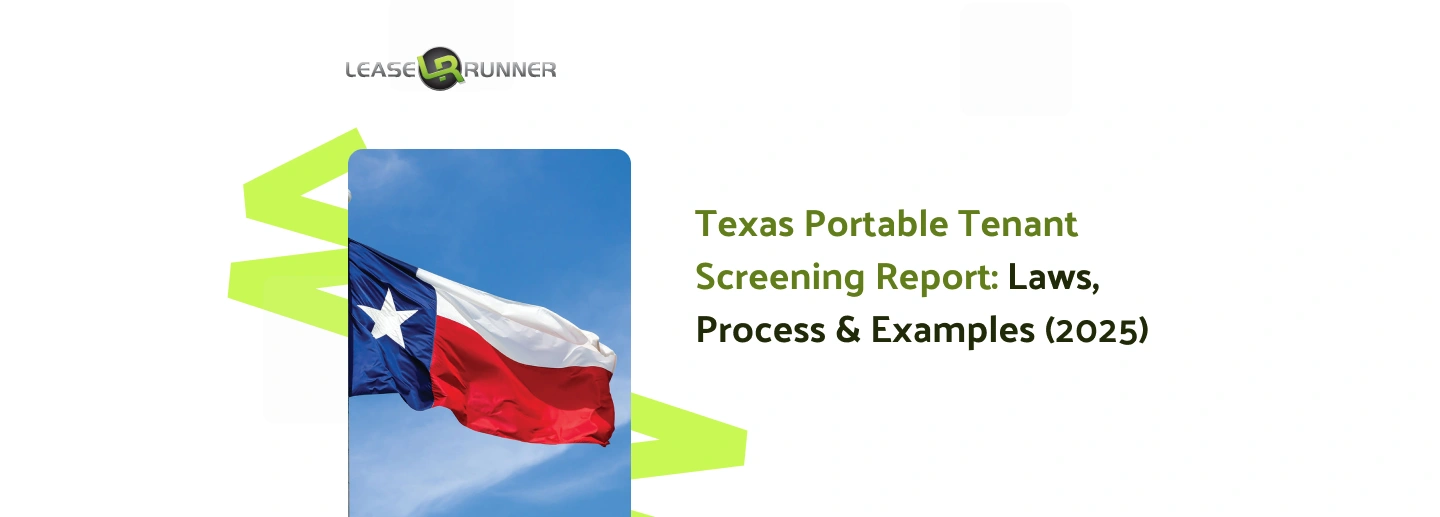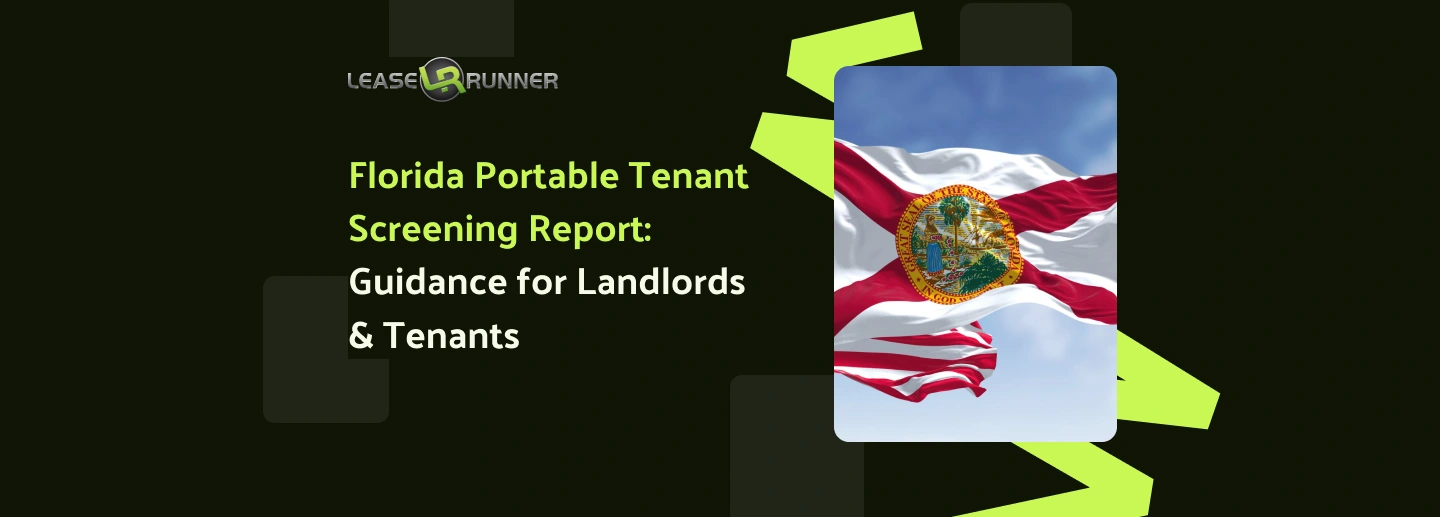
Renting in Texas just got a little easier thanks to the Texas portable tenant screening report. In 2025, new rules give renters the power to share one screening report with multiple landlords, saving time and money. But what does that mean for you? This article will break down the law, the process, and what it looks like in real life!
What Is a Portable Tenant Screening Report in Texas?

A Texas portable tenant screening report is a renter-generated screening document, often called a Reusable Tenant Screening Report, that contains key background information like credit history, eviction records, and rental references. This report can be shared with multiple landlords during the rental application process.
For landlords, it speeds up tenant screening by providing verified information upfront. For tenants, it means they only need to complete one screening report to apply for several properties, saving time and money.
In Texas cities like Houston, Austin, and Dallas, this option is gaining popularity, especially with updated 2025 Texas tenant screening laws encouraging more streamlined leasing practices. For landlords, it offers quicker decisions. For renters, it’s a more affordable and efficient path to finding a new home.
No more filling out the same forms over and over. One verified, trustworthy report helps you (or your tenant) save time and skip the hassle. 

Solid Screening Report. Apply Anywhere
Pros & Cons of Portable Tenant Screening in Texas
Using a tenant screening report, Texas comes with a clear set of upsides and a few tradeoffs.
For Landlords
Pros:
- Cuts down on screening costs and speeds up approvals, especially helpful in fast-moving Texas markets.
- Provides upfront transparency, helping landlords make quicker decisions.
Cons:
- Reports can be outdated or incomplete, leading to potential gaps in tenant vetting.
- No control over which screening service produces the report.
- May lack supplemental details landlords often rely on, requiring extra follow-up.
For Tenants
Pros:
- One report can be reused for multiple applications, saving time and application fees.
- Easier to identify and dispute errors before sharing the report.
Cons:
- Not all landlords accept portable reports
- Report may expire quickly (usually 30 days)
- Limited space for extra information like references or special circumstances
What a Portable Tenant Screening Report Contains?

A Texas portable tenant screening report contains the major components landlords need to evaluate rental applicants. However, it’s still important to understand what is and isn’t covered.
LeaseRunner’s Portable Tenant Screening Report uses payroll and bank data to verify an applicant’s current financial situation. This gives landlords a more reliable way to assess rental risk.
1. Payroll Report
This section uses the applicant’s bank records to confirm income. It’s useful when credit history is limited or missing. It shows:
- Direct payroll deposits from employers
- Consistency of income over time
- Whether the applicant has a steady paycheck
No need for pay stubs or employer references. You see the income as it actually arrives in their account.
2. Cash Flow Report
This part looks at real-time activity in the applicant’s bank account. It shows:
- Monthly income and expense patterns
- Whether they’ve paid rent consistently
- Any recurring bills or financial commitments
- Current balances and overall spending behavior
Together, these give you a clear picture of whether someone can afford the rent—without relying on a backward-looking credit report.
3. Criminal Background Check
This part checks public records for any past criminal activity. Landlords will find:
- Arrest records
- Convictions (misdemeanors or felonies)
- Outstanding warrants or charges
Each landlord has their own policies on criminal records, and Texas law encourages case-by-case evaluation.
4. Eviction and Rental History
This section shows how tenants have handled past rentals. It may list:
- Previous evictions (court-filed)
- Missed or unpaid rent
- Lease violations
- Positive rental history (e.g., lease durations, no issues)
Landlords want to know if you’ve been a responsible renter. A solid history, even without much detail, goes a long way.
5. Identity Verification
Before anything else, landlords want to know they’re dealing with a real person using their own identity. This part checks:
- Full legal name
- Date of birth
- Social Security number (or other ID)
- Matching documents (like a driver’s license)
This step helps prevent fraud and makes sure the report truly belongs to the person applying.
6. Income/Employment Verification
To ensure a tenant can afford rent, most reports include:
- Stated monthly or annual income
- Employer name and contact info
- Work history
- Pay stubs or documents that confirm income
Some screening services pull this data automatically, while others ask the renter to upload proof.
Pro Tip:
A portable tenant screening report Texas usually does not have:
- Personal or landlord references
- Pet history (e.g., breed, behavior, past approvals)
- Letters of explanation for low credit scores or past evictions
- Custom documents like cover letters or resumes
While the portable tenant screening report provides valuable insights, it is essential to complement it with additional information that may not be included, such as personal or landlord references, pet history, and letters of explanation. Keep these handy separately to ensure a comprehensive understanding of the applicant’s background and suitability for your property. Collecting this supplementary information can help you make a more informed decision and avoid potential surprises down the road.
Texas Portable Tenant Screening Report Example
One reliable option for a Texas portable tenant screening report is the screening package offered by LeaseRunner. Designed to meet FCRA (Fair Credit Reporting Act) standards, LeaseRunner's reports are built for both legal compliance and convenience.
LeaseRunner allows tenants to order their own tenant screening report Texas and securely share it with multiple landlords. There’s no need to repeat the process for each rental application.
Each report from LeaseRunner includes:
- A full report of real-time activity in the applicant’s bank account or direct data from payroll providers
- A nationwide criminal background check
- A detailed eviction history report
- Identity verification
- Employment and income verification to pay security deposit
This Texas portable tenant screening report example is ideal for renters applying in high-demand Texas cities like Houston, Austin, and Dallas, where timing matters and strong applications stand out.
Legal Requirements for Tenant Screening in Texas (Texas Property Code § 92.3515)
In Texas, there’s no specific law requiring landlords to accept a portable tenant screening report. It’s completely up to the landlord to decide. However, all standard Texas tenant screening laws still apply.
Here are the key legal requirements renters and landlords should keep in mind:
Written Consent Is Required
Before pulling or reviewing any tenant screening report, the tenant must give written permission. This is required by both Texas law and the federal Fair Credit Reporting Act (FCRA). Landlords should never review a report without this clear, written okay.
Screening Criteria Must Be Disclosed
Landlords are required to disclose their rental criteria in writing before accepting any application or fee. A few things like:
- Minimum credit score
- Income requirements
- Pet restrictions
- Background check standards
This helps renters understand what’s expected and prevents misunderstandings down the line.
Application Fees Are Conditional
Landlords in Texas can charge application fees, but those fees must be refundable if:
- The landlord doesn't provide their screening criteria in writing, or
- They don’t decide within 7 days (unless otherwise stated)
FCRA and Fair Housing Act Must Be Complied
Even when using a portable report, landlords must follow the Fair Credit Reporting Act (FCRA) and Fair Housing Act.
- Using the information fairly and legally
- Not discriminating based on race, gender, disability, family status, or other protected classes
- Providing notice if a rental application is denied because of something in the report
These laws apply in every case, whether a landlord uses their own screening tools or accepts a portable report.
Pro Tip:
Can Texas landlords accept portable tenant screening reports?
Yes, they’re allowed, but not required to accept them. Since no state law mandates it, each landlord can decide for themselves. Renters should always ask early in the process to avoid confusion.
5 Steps for Tenants to Get a Portable Screening Report in Texas

Getting a Texas portable tenant screening report is easier than most people expect. It only takes a few steps to create a shareable report that can be used with multiple rental applications.
Step 1: Choose a Trusted Screening Provider
Start by picking a reputable screening service that meets FCRA standards. LeaseRunner is a reliable choice, offering full reports that include background, eviction history, identity verification, and employment checks.
Step 2: Pay for and Authorize the Report
Once you’ve selected the provider, you’ll need to pay for the report and give permission for your information to be reviewed. This authorization is required under federal law.
Step 3: Download or Request a Shareable Copy
After the report is complete, download a PDF or request a secure link that you can share with landlords. Most services let you control how long the report is accessible and who can view it.
Step 4: Send It to the Landlord with Written Consent
When you apply for a rental, include the screening report along with your application, along with written consent allowing the landlord to view it. You can simply write, “I authorize [Landlord Name] to review my attached tenant screening report.”
Step 5: Keep a Copy
Always save a copy of the report for your records. You might need to re-share it with multiple landlords, especially if you’re applying to more than one place within a short period (reports are typically valid for 30 days).
How to Accept & Use a Portable Screening Report as Texas Landlords
Landlords in Texas are allowed, but not required, to accept portable tenant screening reports. When a renter provides one, the process can be just as smooth and thorough as running your own, as long as you follow these steps:
Step 1: Verify the Report’s Date and Completeness
Check that the report is recent, ideally within the last 30 days, and covers the key components: credit history, background check, eviction records, identity, and income verification.
Step 2: Confirm Written Consent from the Applicant
Before reviewing the report, make sure you’ve received written consent from the tenant. This can be a signed statement or a simple note attached to the application that says you’re authorized to view the report.
Step 3: Evaluate the Report Against Your Criteria
Use your standard rental criteria to review the report. Check the credit score, look at any red flags, and review the tenant’s rental and employment history. Portable reports still need to meet your screening standards.
Step 4: Provide an Adverse Action Notice If Rejecting
If you decide not to approve the tenant based on something in the report, you must give an adverse action notice. This is required under the Fair Credit Reporting Act (FCRA) and must include the reason for the denial and the name of the report provider.
Step 5: Make the Decision
Once you’ve reviewed the report and completed any follow-up, you can move forward confidently. Accepting a portable report can speed up your process while still protecting your rental property and standards.
When Should a Landlord Reject a Portable Screening Report?
A landlord in Texas can reject a portable tenant screening report for a few valid reasons. Rejection may be reasonable when:
- The report is outdated (typically older than 30 days)
- Key sections are missing (like income verification or background check)
- The report was not shared with proper written consent
- The tenant doesn’t meet your published screening criteria
- There are signs the report has been tampered with or altered
Rejecting a report must always be based on consistent, pre-established criteria. Be sure to document your reason and provide the required adverse action notice if the report influenced your decision.
Bottom Line
Renting in Texas doesn’t have to feel overwhelming. With a Texas portable tenant screening report, tenants can take control of the process, and landlords still get the clear insights they need to make smart decisions. For more tips and updates, follow the LeaseRunner blog and stay informed!
FAQs
Q1. What shows up on a tenant screening report?
LeaseRunner’s Portable Tenant Screening Report should have:
- Payroll Report, Cash Flow Report
- Criminal background check (felonies, misdemeanors, arrest records)
- Eviction history, including court-filed evictions or unpaid rent
- Rental history from previous landlords (if available)
- Identity verification to confirm your legal name and details
- Income and employment verification (usually through documents or employer confirmation)
Some reports may also include public records like bankruptcies or judgments. Personal references and pet history typically don’t show up directly.
Q2. How to screen tenants in Texas?
To screen tenants in Texas:
- Set clear screening criteria (e.g., minimum credit score, income, background expectations)
- Disclose your criteria in writing before accepting applications
- Get written consent from the applicant before running any reports
- Use a screening service like LeaseRunner to check credit, background, and eviction history
- Evaluate the report fairly and consistently
- If denying an applicant based on the report, send an adverse action notice as required by law
Texas landlords are not required to accept portable tenant screening reports, but they are allowed to.
Q3. Can I get a copy of my tenant screening report?
Yes! If you’re a renter and you've ordered your own tenant screening report, you’ll usually get a full copy via email or a download link.
If a landlord ordered the report, you can request a copy from the screening company. Under the Fair Credit Reporting Act (FCRA), you also have the right to see what’s in your report and dispute any errors.







